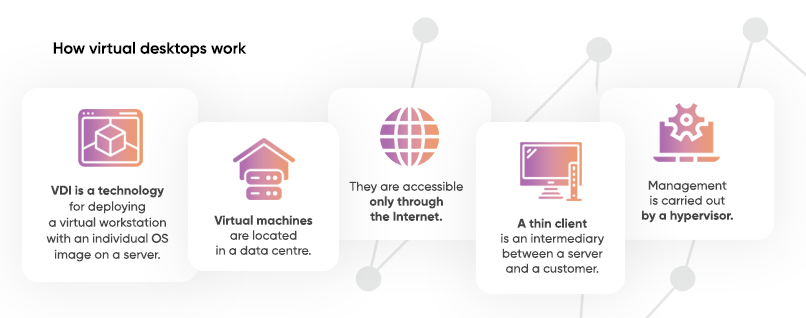VDI (Virtual Desktop Infrastructure) is a desktop virtualisation technology that provides access to corporate infrastructure from a mobile device or a computer. You no longer need to purchase office PCs, repair them or maintain software performance. VDI model is becoming a business standard preventing personal and corporate information from getting mixed up.

VDI helps companies to
- control access to corporate data,
- prevent downtime related to obsolete equipment or software failure,
- convert capital expenses into operating expenses,
- organise remote work,
- reduce administration in branches,
- standardise devices and technologies used.
What is a virtual desktop
A virtual desktop simulates a physical desktop. The application creates a workspace with a ready-made set of software on the server. To access a virtual desktop, the user only needs the Internet.
Virtual desktop is suitable for solving both standard and resource-intensive tasks, for example, when processing large amounts of data, audio and video files. VDI guarantees scalability, reliability and cost-effectiveness of business processes.
How virtual desktops work
To understand the benefits of a virtual desktop, you need to know what VDI is and how it works.
- VDI is a technology for deploying a virtual workstation with an individual OS image on a server.
- Virtual machines are located in a data center.
- They are accessible only through the Internet.
- A thin client is an intermediary between a server and a customer.
- Management is carried out by a hypervisor.
There are two types of cloud VDI. Persistent VDI solutions are suitable for IT specialists. They provide maximum personalisation and application compatibility. In non-persistent solutions, user personalisation is deleted when the work is completed.
The cost of VDI consists of
- format (own/leased equipment),
- hardware,
- platform, number of client devices and required licences,
- calculated min and max network load,
- required performance,
- backups frequency,
- settings of recovery mechanisms.
VDI is used for
- organising remote work,
- performing a variety of tasks for any number of users,
- ensuring security and preventive elimination of threats,
- using personal devices for corporate work.
Advantages and disadvantages of virtual desktops
Pros of VDI
- working from anywhere,
- savings on IT and equipment for employees,
- certification conformity upgrade, incl. up to European Data Protection Regulation (GDPR),
- data security, reduced risk of sensitive data loss,
- centralised management of virtual desktops,
- access to data center functionality (security settings, backup, emergency recovery).
Cons of VDI
- not all applications are supported,
- high throughput is required,
- high network security requirements,
- lengthy deployment in big companies with many employees.
What is VDI and how to use it for remote work
Write us a message to get additional information.
or book a free consultation
VDI solutions are suitable for large network companies facing security problems, PC performance issues, administrator overload or overmanning. Small and medium-sized businesses may find alternative solutions more attractive.